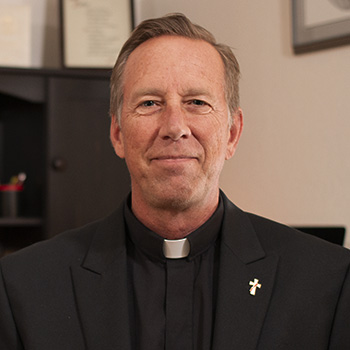The Catholic tradition of making the sign of the cross dates to the very earliest Christian times. Tertullian, writing in 211, said, “We furrow our forehead with the sign [of the cross].”
By F. K. Bartels
25 August 2009
The sign of the cross is the most frequently used Catholic sacramental. In the Byzantine rite, it is made by joining the thumb and next two fingers together, which represents the Holy Trinity. The remaining two fingers are folded down against the palm, which represents the two natures in the one Person of Christ. The joined fingers are then touched first to the forehead, second to the breast, and, third, moved from the left to the right shoulder.
In the Latin rite, the thumb and first two fingers are extended; the last two fingers are closed. The Holy Trinity is represented: the strong thumb represents the Father; the third finger represents the Son; the index finger represents the Holy Spirit who proceeds from the Father and the Son.
Why is the sign of the cross important? It is, historically, an ancient tradition which identifies Christians as the followers of Christ, living by the rule of the cross, and has been in use since the apostolic age. As historical Christians who trace their roots back two-thousand years to Christ himself, Catholics take Christian history seriously, linking it to the present sacramentally; i.e. to the here and now through outward signs which represent an invisible reality. Through the use of the sign of the cross, God’s economy of salvation is visibly celebrated and made present.
Further, the sign of the cross is a sign of the Holy Trinity: the foundation of our Christian faith. That is why Catholics make the sign of the cross before prayer. We are acknowledging our belief in and our dependence on the Holy Trinity, the origin and end of our life and all that we believe as Christians. Therefore we begin all our prayers by tracing the cross on our body, which is an affirmation of what we believe and to Whom we give our free and loving obedience.
Also, in order to better understand why Catholics cherish the sign of the cross, one has to understand the importance of tradition. If, during the apostolic age, those first members of the Catholic Church traced the cross upon themselves, there is no reason to discard such a tradition later. Not making the sign of the cross is less, not more. Catholics simply desire to maintain a proper continuity to the past, to live on the world today while yet holding on to those ancient practices which distinguish them as Christ’s followers. Catholics want more, so to speak. They take seriously the unchanging nature of Catholicism, with its traditions which date back thousands of years. Catholics desire to maintain richness, depth and beauty; not, on the other hand, embrace a sterile, empty form of modern worship devoid of the symbols of our faith.
The sign of the cross is also considered a sacramental, as mentioned above. What is a sacramental? Sacramentals are special prayers, objects or actions, the use of which obtain spiritual benefits through the prayers of the Church to God.
The sign of the cross is a prayer and a blessing; therefore it obtains spiritual benefits. The sign of the cross is beautiful and rich; it expresses perfection as it symbolizes the Holy Trinity, in which all perfection exists. It nurtures holiness, making present the cross of Christ as we trace its outline upon our body. It is Christian history; it glorifies God; it symbolizes the universal Christian community whose life is sustained in the Body of Christ. The sign of the cross is, therefore, distinctly Catholic, as it has been for twenty-centuries.
*****
Photo Credit: Image modified. commons.wikimedia.org/wiki/File:Cristo_crucificado.jpg”>wikimedia commons

Deacon Frederick Bartels is a member of the Catholic clergy who serves the Church in the diocese of Pueblo. He holds an MA in Theology and Educational Ministry, and is a Catholic educator, public speaker, and evangelist who strives to infuse culture with the saving principles of the gospel. For more, visit YouTube, iTunes and Twitter.

Leave a Reply